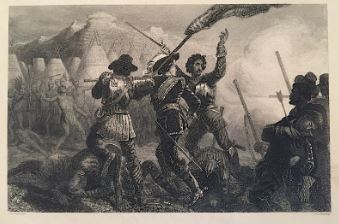Invasion from All Directions—Stolen Lands, Stolen Peoples 1600-1699
1637
“Thanksgiving Day” Massacres

On June 5, Captain Mason attacks a Pequot village near present-day Stonington and massacres the community. Following an especially successful raid against the Pequot in what is now Stamford, Connecticut, the churches announce a second day of “thanksgiving” to celebrate victory. Reportedly, during the feasting, the hacked-off heads of Natives are kicked through the streets like soccer balls. On July 28, a third attack and massacre occur near present-day Fairfield and the Pequot “War” comes to an end. The day after the massacre, William Bradford, the governor of Massachusetts Bay Colony, writes that from that day forth shall be a day of celebration and thanksgiving for subduing the Pequot and “For the next 100 years, every Thanksgiving Day ordained by a Governor was in honor of the bloody victory, thanking God that the battle had been won.” This event marks the first actual Thanksgiving. During this period of history, the Puritans and other English colonists generally declared a day of thanksgiving to celebrate the successful massacre of Native communities and to honor “victories” ordained by God rather than celebrating successful harvests (Oxendine, 2019; Native Voices, "AD 1637: English settlers burn Pequot village").